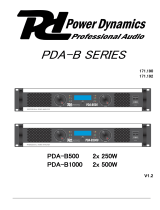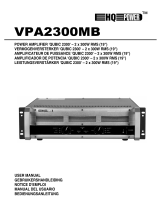
ENGLISH OPERATION MANUAL
JB SYSTEMS
®
5/42 D2-900 ~ D2-1200 ~ D2-1500
16. BRIDGE SPEAKON OUTPUT: use this Speakon
®
connector to connect your speaker cabinet in bridge
mode. Refer topoints 5 and 12 for more information. Wiring of this connector is as follows:
POS(+) = Speakon connectorPIN1+ and PIN2+
NEG(-) = Speakon connector PIN1- and PIN2-
17. CH1 FILTER CONTROL: used to adjust the crossover frequency of the internal crossover for channel1.
You can adjust the frequency between 90Hz and 250Hz: perfect to make an active system based on a
subwoofer + top cabinet! Formost subwooferapplications acrossover point between 90Hz and 150Hz is
OK, however while listening and comparing you will easily find theoptimal settings for your system.
18. CH1 FILTERSWITCH: used to set the desired filter for channel1: high pass, low pass or no filter:
High pass filter (HPF): use this filter when you want to connect a small top cabinet to the output
ofchannel1. See the chapter “How to use” for more information.
Low pass filter (LPF): use this filter when you want to connect a subwoofer cabinet to the output
ofchannel1. See the chapter “How to use” formore information.
No filter: use this option if you want to connect a normal full range speaker cabinet to channel1,
this is the most common user mode.
19. CH2 FILTERCONTROL: Exactly thesame function as described in number 17 but now forchannel 2.
20. CH2 FILTERSWITCH: Exactly the same function as described in number 18 but now forchannel 2.
21. GROUND LIFT switch: In some cases nasty hum noises can occur due to ground loops in your setup.
Setting the Ground lift switch to the position “lift” breaks the ground loop between the amplifier and the
chassis grounds ofvarious other components in yoursetup. Asa result the hum noisesdisappear.
22. RESETbutton: this amplifier uses an automatic fuse. When the fuse is blown, simply press the button to
rearm it.
23. MAINS input: When all audio cables are connected,you can connect this cable to mains outlet.
HOW TO USE
Normal usein stereo mode
Will be used in most cases for a simple setup with 2 speaker cabinets.
Connect the audio signal tobothinputs (11)
Connect thespeaker cabinets toboth outputs (15)
Put both filter switches (18) and (20) to “no filter”
Put the mode switch (13) to stereo
Closethe gain controls (2)
Switch the amplifier on (9)
Open thegain controls (2) to the desired level.
Used with the crossover filters to obtain an active stereo system
Please note that when used in an active setup you need 2 amplifiers to obtain a stereo system. There are 2
different options to connect the amplifiers:
Option1 – one amplifier per side for high and low outputs
In this setup we use channel1 for the top cabinet and channel2 for the subwoofer on both amplifiers.
We use one amplifier for the left channel and one amplifier for the right channel .
Connect the audio signal only tothechannel1 input (11)
Put themode switch (13) to mono
Connect the top cabinet to the output
(15) ofchannel1
Connect the subwoofer to the output
(15) ofchannel2
Put the filter switch of channel1 (18) to
“high pass filter”
Adjust the crossover frequency of
channel1(17)
Put the filter switch of channel2 (20) to
“lowpass filter”
Adjust the crossoverfrequency of channel2 (19)
Closethe gain controls (2)
Switch the amplifier on (9)
Open the gain controls (2) to the desired levels so you have a nice balance between the top
cabinet and the subwoofer.
ENGLISH OPERATION MANUAL
JB SYSTEMS
®
6/42 D2-900 ~ D2-1200 ~ D2-1500
Further adjust the crossover points of the filters (normally the crossover points of both channels
should be equal)
Remark: if your top cabinets can support low frequencies (example: top cabinets based on 15” or
2x15”woofers), you can set channel1 to “no filter”. The top cabinets are not filtered which results in
morepunch forthelowfrequencies.
Option2 – one amplifier for top cabinets and one amplifier for subwoofers
In this setup we use both channels of amplifier A for the top cabinets and both channels of amplifier
B for the subwoofer(s). Both amplifiers receive a normal stereo audio signal.
Connect the stereo audio signal to the inputs of both amplifiers (use a short XLR-cable to daisy
chain theinputs ofboth amplifiers)
Put the modeswitch of both amplifiers (13) tostereo
Connect the top cabinetsto the outputs (15) ofamplifier A
Connect the subwoofer(s) to the outputs (15) of amplifier B
Put both filter switches on amplifier Ato “high pass filter”
Adjust the crossover frequency (17)
for both channels of amplifier A
Put both filter switches on amplifier B
to “low pass filter”
Adjust the crossover frequency (17)
forboth channels of amplifier B
Close the gain controls (2) on both
amplifiers
Switch both amplifiers on (9)
Open the gain controls (2) of amplifier
A to the desiredlevel
Open the gain controls (2) of amplifier B until have a nice balance between the top cabinets and
thesubwoofer(s).
Further adjust thecrossover points on both amplifiers
Remark: if you onlyuse onepowerful subwoofer,you canswitchamplifier Bto bridge mode and use
the bridge output to connect the subwoofer. In this case only the controls of channel1 should be
used.
Used in bridge mode, without filters
In this case the amplifier has only one mono output but with a much higher output power.
Connect the audio signal tothe input ofchannel1 (11)
Connect thespeaker cabinet to thebridge output (16)
Put both filter switches (18) and (20) to “no filter”
Put themode switch (13) tobridge
Closethe gain controls (2)
Switch the amplifier on (9)
Open the gain control of channel1 (2) to the desired level. (the gain
control of channel2 is notused)
Used in bridge mode, with filters
Belowwe explain how to connect a powerful subwoofer.
Connect the audio signalto theinput of channel1 (11)
Connect the subwoofer tothe bridge output (16)
Put the filter switch ofchannel1 (18) to “low pass filter”
Adjust thecrossover frequency of channel1 (17)
Put themode switch (13) tobridge
Closethe gain controls (2)
Switch the amplifier on (9)
Open the gain control of channel1 (2) to the desired level. (the gain control of channel2 is not used)






